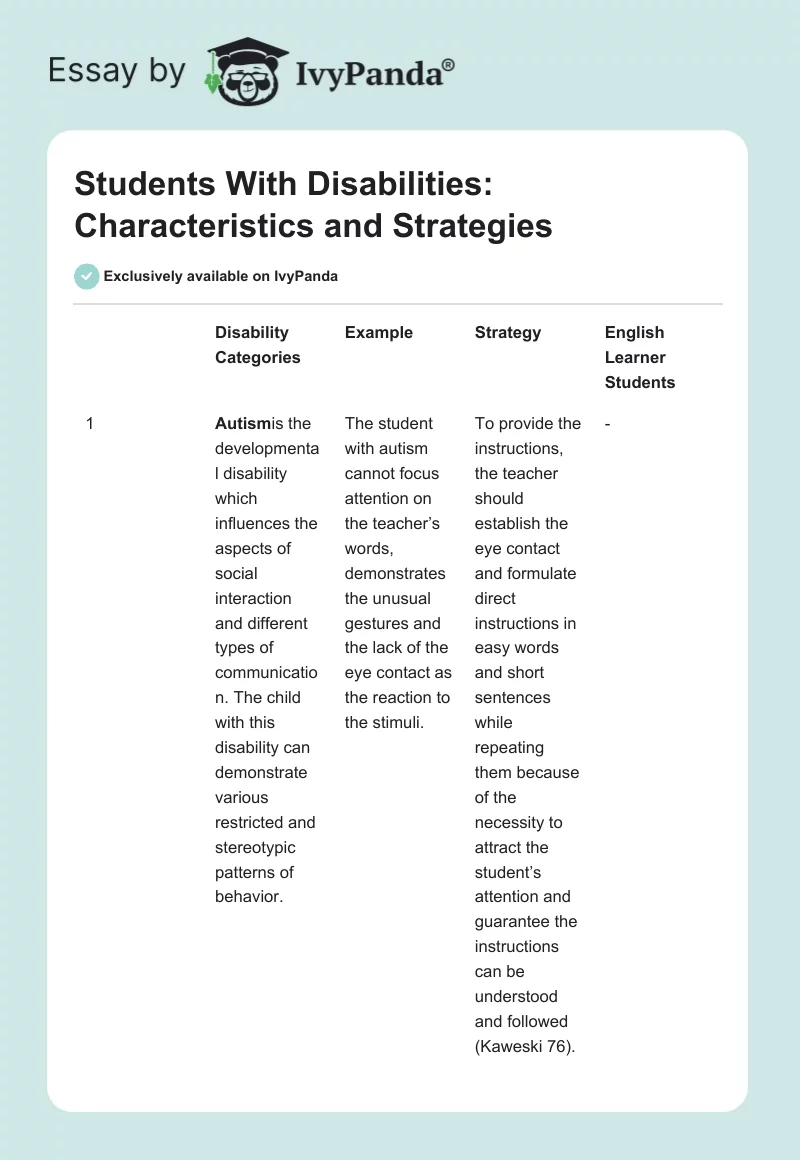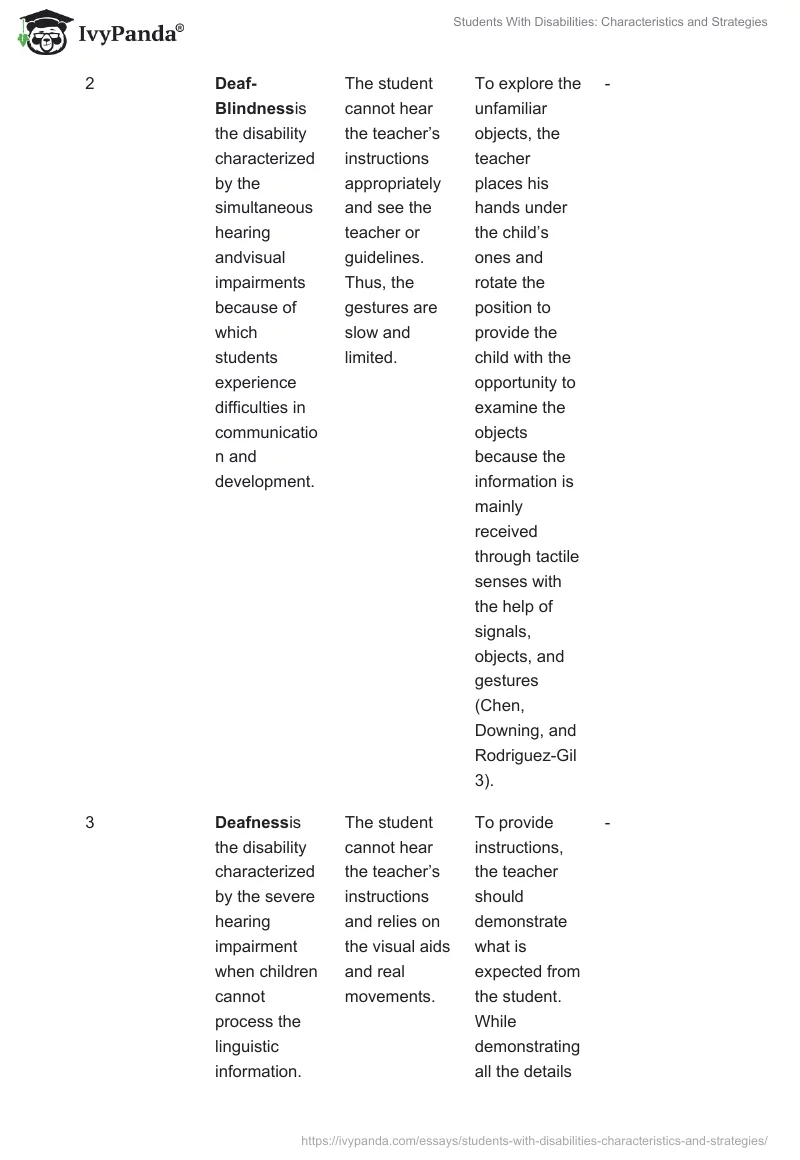| Disability Categories | Example | Strategy | English Learner Students | |
| 1 | Autism is the developmental disability which influences the aspects of social interaction and different types of communication. The child with this disability can demonstrate various restricted and stereotypic patterns of behavior. | The student with autism cannot focus attention on the teacher’s words, demonstrates the unusual gestures and the lack of the eye contact as the reaction to the stimuli. | To provide the instructions, the teacher should establish the eye contact and formulate direct instructions in easy words and short sentences while repeating them because of the necessity to attract the student’s attention and guarantee the instructions can be understood and followed (Kaweski 76). | – |
| 2 | Deaf-Blindness is the disability characterized by the simultaneous hearing and visual impairments because of which students experience difficulties in communication and development. | The student cannot hear the teacher’s instructions appropriately and see the teacher or guidelines. Thus, the gestures are slow and limited. | To explore the unfamiliar objects, the teacher places his hands under the child’s ones and rotate the position to provide the child with the opportunity to examine the objects because the information is mainly received through tactile senses with the help of signals, objects, and gestures (Chen, Downing, and Rodriguez-Gil 3). | – |
| 3 | Deafness is the disability characterized by the severe hearing impairment when children cannot process the linguistic information. | The student cannot hear the teacher’s instructions and relies on the visual aids and real movements. | To provide instructions, the teacher should demonstrate what is expected from the student. While demonstrating all the details of the activities step by step, the teacher guides the student in his actions because of the impossibility to provide the oral instructions (Cawthon 215). | – |
| 4 | Emotional Disturbance means that a child cannot learn, build interpersonal relationships, demonstrates the inappropriate behavior, depression, and fears (schizophrenia). | The student prevents the other students from studying activities and demonstrates aggression. | The teacher should attract the student’s attention, to re-focus his attention to the important objects, motivate for the expected activity and reward for it because of the necessity to establish and support the rapport (Nielsen 111-112). | – |
| 5 | Hearing Impairment is the impairment in hearing which is not as severe as deafness, but it affects the child’s educational performance | The student cannot hear clearly the teacher’s instructions and relies on the visual aids. | To provide instructions, the teacher speaks directly to the student while accompanying the words with demonstrating the visuals because it is necessary to use two sensory receivers to guarantee the understanding of the information (“Suggested Teaching Strategies”). | – |
| 6 | Intellectual Disability means limitations in the intellectual functioning which affect the educational performance. | The student cannot understand and follow the teacher’s complex instructions and think abstractly. | The teacher draws the student’s attention to simple objects and relations between them, and guides the student to explore the objects because of the necessity to set simple connections in the child’s mind (Nielsen 153). | – |
| 7 | Multiple Disabilities means that a child has simultaneous impairments, and their combination causes severe limitations in the child’s performance | The student is in the chair for disabled and cannot hear appropriately. | The teacher provides the student with the visual and textual materials to understand the topic and information to address the students’ needs (Nielsen 86). | – |
| 8 | Orthopedic Impairment includes impairments associated with congenital anomaly, diseases, and impairments from other causes. | The student can be limited in his movements because of sitting in the chair for disabled. | The group activities are modified to provide the child with the opportunity to join the circle easily to participate in the group games (Nielsen 85). | – |
| 9 | Other Health Impairment Includes disabilities associated with the limited strength and vitality and increased alertness to the environment. | The child with epilepsy cannot participate in the active games, demonstrate active movements and gestures. | The teacher should provide the student with the opportunity to complete the alternative task associated with the topic, to assist the group in making the poster or a speech because of the necessity to avoid active stimuli (Nielsen 113). | |
| 10 | Specific Learning Disability is a disorder in psychological processes associated with using language. The students cannot listen, speak, read, write, and spell well. | The student with dyslexia cannot read the texts. | The teacher provides the necessary material with the help of audio and video resources and visual aids to guarantee the student’s understanding (Nielsen 100). | |
| 11 | Speech or Language Impairment is a communication disorder associated with articulation and uttering. | The student cannot express the thoughts orally | The teacher adapts the tests to focus on the written examination to make the student feel comfortable (Nielsen 112). | |
| 12 | Traumatic Brain Injury is the disorder associated with the impairments in cognition, language, attention, physical functions. | The student cannot express the thoughts clearly and logically. | The teacher helps to work with visual aids to set the logical connections and relations between the objects to develop the student’s reactions and cognition (Nielsen 130). | |
| 13 | Visual Impairment (Including Blindness) Is the an impairment in vision which influences the child’s educational performance in spite of corrective techniques (“Categories of Disability under IDEA”). | The student cannot see the objects and the teacher clearly or at all. | To address the child’s needs, the teacher provides instructions orally, using the clearest language to describe the activity and tasks because the auditory learning is primary for such children (Moss par. 10). | To address the needs of the English learners, the teacher modifies the verbal instructions to choose the most simple and familiar words. Unfamiliar words are explained orally, with the focus on examples in speech. |
Works Cited
Categories of Disability under IDEA. 2012. Web.
Cawthon, Stephanie. Teaching Strategies in Inclusive Classrooms with Deaf Students. 2001. Web.
Chen, Deborah, June Downing, and Gloria Rodriguez-Gil. “Tactile Strategies for Children Who are Deaf-Blind”. Deaf-Blind Perspectives 8.2 (2001): 1-6. Web.
Kaweski, Walter. Teaching Adolescents with Autism: Practical Strategies for the Inclusive Classroom. USA: Corwin Press, 2011. Print.
Moss, Kate. Teaching Strategies and Content Modifications for the Child with Deaf-Blindness. 1995. Web.
Nielsen, Lee Brattland. Brief Reference of Student Disabilities. USA: Corwin Press, 2008. Print.
Suggested Teaching Strategies. n.d. Web.


